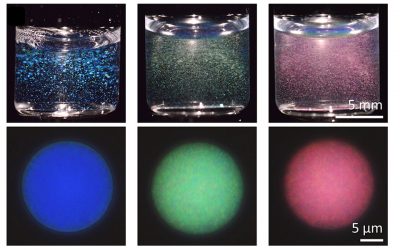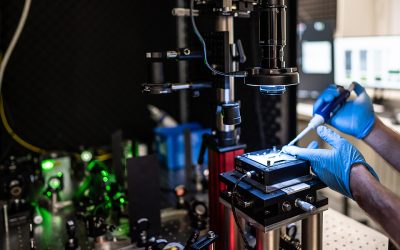Funded in part by the Obama Administration’s American Recovery and Reinvestment Act, Rutgers University have unveiled two microscopy suites, together valued at more than $5.2 million. These instruments are the “best in the world” at producing nanoscale images that will impact scientific developments in disciplines confronting some of society’s greatest challenges, according to Leonard C. Feldman, Director of the Rutgers Institute for Advanced Materials, Devices and Nanotechnology (IAMDN).
“Rutgers has become a global leader in advanced nanoscale materials imaging, bringing to the New Jersey region a new resource for the advancement of scientific research, educational outreach and industrial partnership,” said Feldman, who also serves as Rutgers Vice President of Physical Science and Engineering Partnerships. “We have the beginning of a Rutgers imaging institute through IAMDN that will foster international scientific collaboration to significantly impact research in biomaterials, medical research of cancer and neurology, renewable energy, and telecommunications. These microscopes are without question the most advanced devices utilized in the world today to visualize the atomic structure of new nanoscale materials. The advances they support will empower researchers confronting some of the most daunting global problems today.”
The Recovery Act, the 2009 law signed by President Barack Obama designed to stimulate the economy, provided Rutgers with a nearly $2 million grant through the National Science Foundation (NSF) to create the one-of-a-kind scanning transmission electron microscope (STEM), a next-generation device optimized for the investigation of materials that are vital to energy related applications. The $831 billion economic stimulus package included direct spending in infrastructure, education, health, and energy, federal tax incentives, and expansion of unemployment benefits and other social welfare provisions. In 2010, the White House recognized the STEM project in the report: “100 Recovery Act Projects that are Changing America.”
Rutgers Distinguished Professor Philip E. Batson is bringing the STEM to Rutgers in partnership with Nion Company of Kirkland, Wash., who will commercialize the microscope. A renowned scientist in the area of microscopy, Batson came to Rutgers from IBM for the opportunity to create this cutting-edge device.
“The ability to visualize atomic level structure, bonding and composition is critical to advances in many areas,” said Batson, a faculty member in the Departments of Physics and Astronomy, and Materials Science and Engineering. “This STEM represents a leap ahead in electron spectroscopy capabilities required for the further development of nanoscale science. We can now observe the function of structures that contain only a few atoms. This new capability will be invaluable to understanding materials for energy storage and production, nanoelectronics and catalysis.”
Feldman said that the uniqueness of the STEM device has already been noted by the U.S. Department of Energy, which has sent representatives from its Brookhaven National Laboratory in New York to discuss the possibility of their use of the STEM. “Both of these microscopes are not available anywhere else,” Feldman said. “We are confident that public and private institutions from all over the world will come to Rutgers to utilize the technology.”
NSF also provided a more than $1.6 million grant for the helium ion microscope (HIM), a vital tool to reliably perform analysis and modification of nanoscale materials, which have an enormous impact on basic and applied science.
“The helium ion microscope is a novel instrument with unprecedented capability for imaging surfaces,” said Rutgers Physics Prof. Torgny Gustafsson, principal investigator in the development of HIM. “From drug delivery to the creation of nanometer orifices to explore DNA sequencing and the formation of quantum structures for advanced computing and communications, the discoveries of new science and technologies with the helium ion microscope are limitless.”
Partnering with Batson as co-principal investigators on STEM are Rutgers faculty members Jing Li, Department of Chemistry and Chemical Biology; Frederic Cosandey, Department of Materials Science and Engineering; and Sang-Wook Cheong, Department of Physics and Astronomy. Nion Company President and Co-founder Dr. Ondrej Krivanek also served as co-principal investigator.
Partnering with Gustafsson on HIM as co-principal investigators are Rutgers faculty members Feldman, Departments of Physics and Astronomy, and Materials Science and Engineering; Eva Andrei, Department of Physics and Astronomy; Adrian Mann, Departments of Biomedical Engineering, and Materials Science and Engineering; and Laura Fabris, Department of Materials Science and Engineering.
IAMDN officially unveiled the technology during the Laboratory for Surface Modification’s 28th Annual Symposium, entitled Advances in Nanoscale Materials Imaging, held on the Busch Campus where the microscopes are located. The program featured presentations by some the world’s leading microscopy experts including: Professor John Silcox of Cornell University; Dr. John Notte, Director, Research and Development of Carl Zeiss Microscopy; Dr. J. Albert Schultz, President of Ionwerks, Inc.; and Krivanek.
Source: Rutgers Institute for Advanced Materials, Devices and Nanotechnology
















